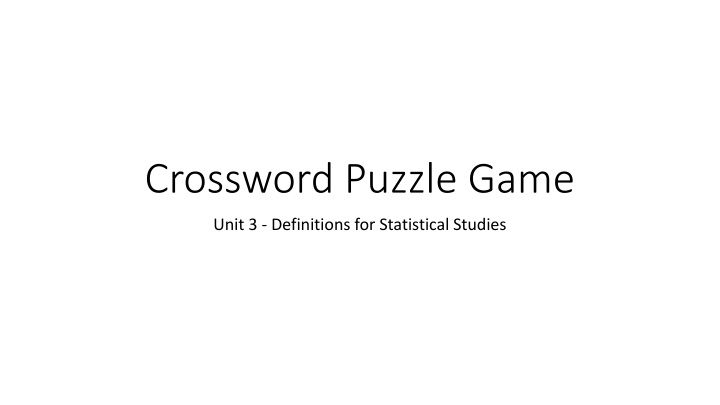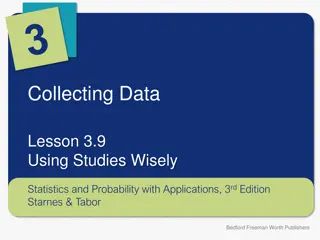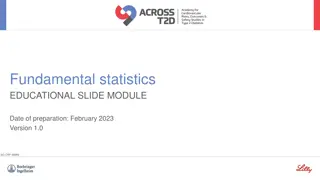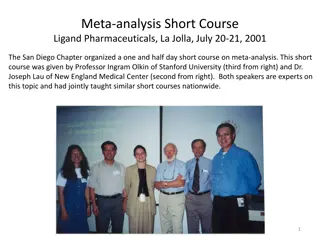Statistical Studies Vocabulary and Definitions
Explore key definitions and concepts related to statistical studies, including terms such as census, cluster sampling, experimental study, histogram, placebo effect, questionnaire, secondary research, simple random sampling, statistical bias, and more. Gain insights into the vocabulary and principles essential for understanding statistical studies and conducting research effectively.
Download Presentation

Please find below an Image/Link to download the presentation.
The content on the website is provided AS IS for your information and personal use only. It may not be sold, licensed, or shared on other websites without obtaining consent from the author.If you encounter any issues during the download, it is possible that the publisher has removed the file from their server.
You are allowed to download the files provided on this website for personal or commercial use, subject to the condition that they are used lawfully. All files are the property of their respective owners.
The content on the website is provided AS IS for your information and personal use only. It may not be sold, licensed, or shared on other websites without obtaining consent from the author.
E N D
Presentation Transcript
Crossword Puzzle Game Unit 3 - Definitions for Statistical Studies
Vocab Words Census Definitions a usually complete enumeration of a population In a cluster sample, the sampling unit is a collection of population units, not single population units. For example, techniques for adjusting the U.S. census start with a sample of geographic blocks, then (try to) enumerate all inhabitants of the blocks in the sample to obtain a sample of people. This is an example of a cluster sample. Cluster sampling What distinguishes an experiment from an observational study is that in an experiment, the experimenter decides who receives the treatment. Experimental study In plotting a histogram, one starts by dividing the range of values into a set of non-overlapping intervals, called class intervals, in such a way that every datum is contained in some class interval. Bin size is the size of this class interval. Interval width
The belief or knowledge that one is being treated can itself have an effect that confounds with the real effect of the treatment. Subjects given a placebo as a pain-killer report statistically significant reductions in pain in randomized experiments that compare them with subjects who receive no treatment at all. This very real psychological effect of a placebo, which has no direct biochemical effect, is called the placebo effect. Administering a placebo to the control group is thus important in experiments with human subjects; this is the essence of a blind experiment. Placebo effect a set of printed or written questions with a choice of answers, devised for the purposes of a survey or statistical study. Questionnaire Random lacking a definite plan, purpose, or pattern Secondary research is using information that has already been produced by other people. A secondary source is used by a person usually not present at the event and relying on primary source documents for information. Secondary data
A simple random sample from a population is a random sample drawn by a procedure that is equally likely to give every collection of units from the population; that is, the probability that the sample will consist of any given subset of n of the N units in the population is 1/NCn. Simple random sampling is sampling at random without replacement (without replacing the units between draws). A simple random sample of size n from a population of N n units can be constructed by assigning a random number between zero and one to each unit in the population, then taking those units that were assigned the n largest random numbers to be the sample. A measurement procedure or estimator is said to be biased if, on the average, it gives an answer that differs from the truth. The bias is the average (expected) difference between the measurement and the truth. For example, if you get on the scale with clothes on, that biases the measurement to be larger than your true weight (this would be a positive bias). Simple random sampling Statistical bias
Across 3. Study that includes a treatment. 5. The difference between the truth and the statistic. 6. Show of improvement from those in the control group. 7. By chance 8. Sampling of an entire group of a population. 9. Bin size Down 1. Group chosen by chance where each participant has a equal chance of getting chosen. 2. Written or printed survey. 4. Data collected by someone other than the researcher. 8. Complete description of a population.
study made or done without sight of certain objects or knowledge of certain facts that could serve for guidance or cause bias Blind study The subjects in a controlled experiment who do not receive the treatment. Control group Data collection The act of or the method by which information is assembled for study. Distort to twist out of the true meaning or proportion In a double-blind experiment, neither the subjects nor the people evaluating the subjects knows who is in the treatment group and who is in the control group. This mitigates the placebo effect and guards against conscious and unconscious prejudice for or against the treatment on the part of the evaluators. Double-blind study Ethics conforming to accepted professional standards of conduct
A fact is information that is indisputable or established beyond doubt or question and/or follows logically. An opinion is information or ideas that are debatable or influenced by personal beliefs or ideas. Fact/opinion the act of passing from statistical sample data to generalizations (as of the value of population parameters) usually with calculated degrees of certainty. Inference consent to participate in an experiment by a subject after achieving an understanding of what is involved Informed consent Margin of error A measure of the uncertainty in an estimate of a parameter. Participant A person who participates in an activity or event. A pilot study, pilot project or pilot experiment is a small scale preliminary study conducted in order to evaluate feasibility, time, cost, adverse events, and effect size in an attempt to predict an appropriate sample size and improve upon the study design prior to performance of a full-scale research project. Pilot study
The belief or knowledge that one is being treated can itself have an effect that confounds with the real effect of the treatment. Subjects given a placebo as a pain-killer report statistically significant reductions in pain in randomized experiments that compare them with subjects who receive no treatment at all. This very real psychological effect of a placebo, which has no direct biochemical effect, is called the placebo effect. Administering a placebo to the control group is thus important in experiments with human subjects; this is the essence of a blind experiment. Psychological effect any of the three values that divide the items of a frequency distribution into four classes with each containing one fourth of the total population; also : any one of the four classes Quartile Random assignment is a procedure used in experiments to create multiple study groups that include participants with similar characteristics so that the groups are equivalent at the beginning of the study. The procedure involves assigning individuals to an experimental treatment or program at random, or by chance (like the flip of a coin). This means that each individual has an equal chance of being assigned to either group. Usually in studies that involve random assignment, participants will receive a new treatment or program, will receive nothing at all or will receive an existing treatment. When using random assignment, neither the researcher nor the participant can choose the group to which the participant is assigned. Random assignment
Random sampling The method of choosing a random sample. Sample mean An average of sample characteristics. an interpretation of statistical data that indicates that an occurrence probably was the result of a causative factor and not simply a chance result. Statistical significance at the 1% level indicates a 1 in 100 probability that a result can be ascribed to chance. Statistical significance In random sampling, sometimes the sample is drawn separately from different disjoint subsets of the population. Each such subset is called a stratum. (The plural of stratum is strata.) Samples drawn in such a way are called stratified samples. Estimators based on stratified random samples can have smaller sampling errors than estimators computed from simple random samples of the same size, if the average variability of the variable of interest within strata is smaller than it is across the entire population; that is, if stratum membership is associated with the variable. Stratified sampling Univariate characterized by or depending on only one random variable
Across 1. Choosing by chance. 5. The act of or the method by which information is assembled for study. 7. Uncertainty of a parameter. 10. Average of part of the group under study. 14. Codes of acceptable conduct. 15. Placebo effect. 17. Truth / Belief. 18. To twist or corrupt. 19. One fourth of a population. 20. A person who is involved in an activity Down 2. level of confidence that statistic if reflective of parameter. 3. Dependent on only one variable. 4. Knowing the risks and agreeing to participate anyway. 6. Using sample data to make population generalizations. 8. Study done with no knowledge of who is in control group. 9. Study done with no guidance or bias. 11. Determining who gets which treatment by chance. 12. Dividing a population into subgroups and choosing samples from subgroups. 13. Study done to determine how to perform a larger study. 16. Group not receiving treatment.
In hypothesis testing, a null hypothesis (typically that there is no effect) is compared with an alternative hypothesis (typically that there is an effect, or that there is an effect of a particular sign). For example, in evaluating whether a new cancer remedy works, the null hypothesis typically would be that the remedy does not work, while the alternative hypothesis would be that the remedy does work. When the data are sufficiently improbable under the assumption that the null hypothesis is true, the null hypothesis is rejected in favor of the alternative hypothesis. Alternative hypothesis a number that is calculated by adding quantities together and then dividing the total by the number of quantities A measurement procedure or estimator is said to be biased if, on the average, it gives an answer that differs from the truth. The design of an experiment or of a survey can also lead to bias. Bias can be deliberate, but it is not necessarily so. Average Biased sampling method In plotting a histogram, one starts by dividing the range of values into a set of non-overlapping intervals, called class intervals, in such a way that every datum is contained in some class interval. Bin size is the size of this class interval. Bin size
A sample drawn because of its convenience; it is not a probability sample. For example, I might take a sample of opinions in Berkeley (where I live) by just asking my 10 nearest neighbors. That would be a sample of convenience, and would be unlikely to be representative of all of Berkeley. Samples of convenience are not typically representative, and it is not possible to quantify how unrepresentative results based on samples of convenience are likely to be. Convenience samples are to be avoided, and results based on convenience samples are to be viewed with suspicion. Convenience sampling In surveys, it is rare that everyone who is ``invited'' to participate (everyone whose phone number is called, everyone who is mailed a questionnaire, everyone an interviewer tries to stop on the street ) in fact responds. The difference between the "invited" sample sought, and that obtained, is the nonresponse. In a survey, those who respond may differ from those who do not, in ways that are related to the effect one is trying to measure. For example, a telephone survey of how many hours people work is likely to miss people who are working late, and are therefore not at home to answer the phone. When that happens, the survey may suffer from nonresponse bias. Nonresponse bias makes the result of a survey differ systematically from the truth. Nonresponsive bias
In hypothesis testing, the hypothesis we wish to falsify on the basis of the data is the null hypothesis. The null hypothesis is typically that something is not present, that there is no effect, or that there is no difference between treatment and control. For example, in evaluating whether a new cancer remedy works, the null hypothesis typically would be that the remedy does not work, while the alternative hypothesis would be that the remedy does work. When the data are sufficiently improbable under the assumption that the null hypothesis is true, the null hypothesis is rejected in favor of the alternative hypothesis. Null hypothesis What distinguishes an experiment from an observational study is that in an experiment, the experimenter decides who receives the treatment. Observational study a statistical observation that is markedly different in value from the others of the sample Outlier an inert or innocuous substance used especially in controlled experiments testing the efficacy of another substance (as a drug) Placebo a group of individual persons, objects, or items from which samples are taken for statistical measurement Population The mean of the numbers in a numerical population. For example, the population mean of a box of numbered tickets is the mean of the list comprised of all the numbers on all the tickets. The population mean is a parameter. Population mean
Population parameter A numerical property of a population, such as its mean. Primary data is data, which is collected by the researcher themselves. This kind of data is new, original research information. Primary data A random sample is a sample whose members are chosen at random from a given population in such a way that the chance of obtaining any particular sample can be computed. The number of units in the sample is called the sample size, often denoted n. The number of units in the population often is denoted N. Random samples can be drawn with or without replacing objects between draws; that is, drawing all n objects in the sample at once (a random sample without replacement), or drawing the objects one at a time, replacing them in the population between draws (a random sample with replacement). In a random sample with replacement, any given member of the population can occur in the sample more than once. In a random sample without replacement, any given member of the population can be in the sample at most once. A random sample without replacement in which every subset of n of the N units in the population is equally likely is also called a simple random sample. The term random sample with replacement denotes a random sample drawn in such a way that every n- tuple of units in the population is equally likely. Random sample
a small amount of something that gives you information about the thing it was taken from Sample A sample is a collection of units from a population. See also random sample. Sampling method is the method used to determine the collection of units. Sampling method A number that can be computed from data, involving no unknown parameters. As a function of a random sample, a statistic is a random variable. Statistics are used to estimate parameters, and to test hypotheses. Statistic A systematic sample from a frame of units is one drawn by listing the units and selecting every kth element of the list. For example, if there are N units in the frame, and we want a sample of size N/10, we would take every tenth unit: the first unit, the eleventh unit, the 21st unit, etc. Systematic samples are not random samples, but they often behave essentially as if they were random, if the order in which the units appears in the list is haphazard. Systematic samples are a special case of cluster samples. Systematic sampling
Treatment the act or manner or an instance of treating someone or something A numerical value or a characteristic that can differ from individual to individual is a variable. A variable of interest is the variable under study or being compared. Variable of interest
Across 6. All those in a group under study. 11. Numerical quantity descriptive of a sample. 12. Numerical quantity descriptive of all those in a group. 15. Choosing a sample by what is easy. 16. Part of the group under study. 17. An assumption that a cause does have an effect. 18. New data collected by researcher. 19. What is done to determine a cause and effect relationship. 20. Difference from truth because of lack of participation. Down 1. Mean 2. Study that includes no treatment. 3. An assumption that a cause does not have an effect. 4. choosing in a way that influences the study. 5. Numerical quantity descriptive method is population. 7. Avergage of all in a group. 8. Observation very different from others 9. Characteristic under study 10. Sugar pill. 11. Choosing every fifth one is an example. 13. Size of class interval 14. Group chosen by chance.
Across 5. Truth / Belief 8. Difference from truth because of lack of participation. 10. All those in a group under study. 11. Show of improvement from those in the control group. 14. Study done with no knowledge of who is in control group. 17. Observation very different from others 18. Choosing a sample by what is easy. 20. An assumption that a cause does have an effect. 21. Codes of acceptable conduct 24. Numerical quantity descriptive of a population. 26. New data collected by researcher. 27. An assumption that a cause does not have an effect. 28. Written or printed survey. 30. Sugar pill. 31. Group not receiving treatment. 32. Avergage of all in a group. 33. Study done to determine how to perform a larger study. 34. Knowing the risks and agreeing to participate anyway. 35. Size of class interval Down 1. Choosing in a way that influences the study. 2. Placebo effect 3. level of confidence that statistic is reflective of parameter. 4. Study that includes a treatment. 6. To twist or corrupt 7. Complete description of a population. 9. Study that includes no treatment. 12. A person who is involved in an activity. 13. Using sample data to make population generalizations. 15. The act of or the method by which information is assembled for study. 16. By chance 19. Bin size 22. Sampling of an entire subset of a population. 23. Mean 25. Study done with no guidance or bias. 29. One fourth of a population























